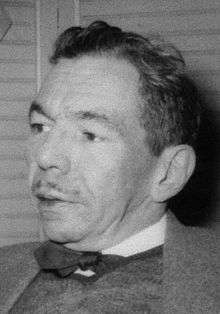William Lindsay Gresham
| William Lindsay Gresham | |
|---|---|
 | |
| Born |
August 20, 1909 Baltimore, Maryland, U.S. |
| Died |
September 14, 1962 (aged 53) New York, New York, U.S. |
| Citizenship | United States |
| Occupation | Author |
| Known for | Nightmare Alley |
William Lindsay Gresham (/ˈɡrɛʃəm/; August 20, 1909 – September 14, 1962) was an American novelist and non-fiction author particularly well-regarded among readers of noir. His best-known work is Nightmare Alley (1946), which was adapted into a 1947 film starring Tyrone Power.
Life and career
Gresham was born in Baltimore, Maryland. As a child, he moved to New York with his family, where he became fascinated by the sideshow at Coney Island. Upon graduating from Erasmus Hall High School in Brooklyn in 1926, Gresham drifted from job to job, and worked as a folk singer in Greenwich Village.[1] In 1937, Gresham served as a volunteer medic for the Loyalist forces during the Spanish Civil War. There, he befriended a former sideshow employee, Joseph Daniel "Doc" Halliday, and their long conversations inspired much of his work,[1] particularly Gresham's two books about the American carnival, the nonfiction Monster Midway and the fictional Nightmare Alley.
Returning to the United States in 1939, after a troubling period that involved a stay in a tuberculosis ward and a failed suicide attempt, Gresham found work editing true crime pulp magazines. In 1942, Gresham married Joy Davidman, a poet, with whom he had two children, David and Douglas. Gresham was an abusive and alcoholic husband. Davidman, an ethnically Jewish atheist, became a fan of the writings of C. S. Lewis, which led eventually to her conversion to Christianity. After a violent encounter with Gresham, who wanted a divorce, Davidman ultimately agreed to end her marriage to Gresham and later married Lewis, their relationship forming the inspiration for the play and movie Shadowlands.
Gresham married Davidman's first cousin, Renee Rodriguez, with whom he had been having an affair and who was herself suffering an abusive marriage.[2] Gresham joined Alcoholics Anonymous and developed a deep interest in Spiritualism, having already exposed many of the fraudulent techniques of popular spiritualists in his two sideshow-themed books and having written a book about Houdini with the assistance of noted skeptic James Randi. He was also an early enthusiast of Scientology but later denounced the religion as another kind of spook racket.[3]
Death
In 1962, Gresham's health began to take a turn for the worse. He had started to go blind and had been diagnosed with cancer of the tongue. On September 14, 1962, he checked into the Hotel Carter, Manhattan — which he had often frequented while writing Nightmare Alley over a decade earlier.[2] There, 53-year-old Gresham took his life with an overdose of sleeping pills. His death went generally unnoticed by the New York press, but for a mention by a bridge columnist.[4] In his pocket they found business cards reading, "No Address. No Phone. No Business. No Money. Retired."[5]
Bibliography
- Nightmare Alley (1946)
- Limbo Tower (1949)
- Monster Midway: An Uninhibited Look at the Glittering World of the Carny (1954)
- Houdini: The Man Who Walked Through Walls (1959)
- The Book of Strength: Body Building the Safe, Correct Way (1961)
- Grindshow: The Selected Writings of William Lindsay Gresham (2013)[6]
References
- 1 2 "Blind Alley: the sad and 'geeky' life of William Lindsay Gresham", from Skeptical Inquirer July–August 2003
- 1 2 Nothing Matters In This Goddamned Lunatic Asylum Of A World But Dough, from Noir Fiction: Dark Highways by Paul Duncan (ISBN 1-903047-11-0)
- ↑ http://www.awpwriter.org/magazine/writers/aprendergast01.htm "One Man's Nightmare:The Noir Journey of William Lindsay Gresham," by Alan Prendergast, a Summer 2006 article in the Associated Writers Program Magazine
- ↑ "Bridge: Death of Gresham, Writer, Loss to Bridge World, Too", by Albert H. Morehead, 25 September 1962, New York Times
- ↑ "10 overlooked novels: how many have you read?". Retrieved 30 June 2016.
- ↑ Centipede Press. Edited by Bret Wood. http://www.centipedepress.com/crime/grindshow.html